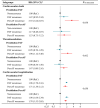Patterns of Postablation Recurrence and Adverse Cardiovascular Outcomes in Patients With Atrial Fibrillation
- PMID: 40247625
- PMCID: PMC12184226
- DOI: 10.1161/JAHA.124.038832
Patterns of Postablation Recurrence and Adverse Cardiovascular Outcomes in Patients With Atrial Fibrillation
Abstract
Background: Atrial arrhythmia recurrence after atrial fibrillation (AF) catheter ablation is conventionally assessed as a binary end point. However, the prognostic value of recurrence patterns is less studied.
Methods and results: This study included patients undergoing catheter ablation from the multicenter China Atrial Fibrillation Registry study (2011-2022). Postablation AF patterns within 1 year were categorized as nonrecurrence, paroxysmal AF recurrence, or persistent AF (PersAF) recurrence. Cardiovascular outcomes included cardiovascular death, thromboembolism, and cardiovascular hospitalization. Cox proportional models with landmark analysis were used to assess the relationship between recurrence patterns and outcomes. Sensitivity analyses were conducted using Fine-Gray models, considering death unrelated to the outcomes as the competing risk and evaluating 2-year recurrence patterns. Among 13 811 patients (mean age, 60.5±10.8 years; 66.1% men), those with preablation PersAF, prior stroke/transient ischemic attack/systemic embolism, and increased left atrial diameter were more likely to develop PersAF postablation. Compared with nonrecurrence, PersAF recurrence was associated with higher risks of cardiovascular death (hazard ratio [HR], 2.03 [95% CI, 1.20-3.43]; P=0.009), thromboembolism (HR, 1.50 [95% CI, 1.09-2.06]; P=0.012), and cardiovascular hospitalization (HR, 1.74 [95% CI, 1.56-1.94]; P<0.001) during a median follow-up of 3.02 years (interquartile range, 1.44-5.03 years), while paroxysmal AF recurrence was only significantly associated with an increased risk of cardiovascular hospitalization (HR, 1.98 [95% CI, 1.83-2.14], P<0.001). Sensitivity analyses yielded consistent results.
Conclusions: Postablation PersAF recurrence was associated with significantly higher risks of cardiovascular death and thromboembolism, compared with paroxysmal AF recurrence and nonrecurrence, indicating the prognostic importance of recurrence patterns.
Registration: URL: www.chictr.org.cn/; unique identifier: ChiCTR-OCH-13003729.
Keywords: atrial fibrillation; cardiovascular death; catheter ablation; patterns of recurrence; thromboembolism.
Conflict of interest statement
Dr Ma reports honoraria from Bristol‐Myers Squibb, Pfizer, Johnson & Johnson, Boehringer‐Ingelheim, Bayer, and AstraZeneca for giving lectures. The remaining authors have no disclosures to report.
Figures



Similar articles
-
Strategy Optimization for a Combined Procedure in Patients With Atrial Fibrillation: The COMBINATION Randomized Clinical Trial.JAMA Netw Open. 2024 Nov 4;7(11):e2445084. doi: 10.1001/jamanetworkopen.2024.45084. JAMA Netw Open. 2024. PMID: 39546313 Free PMC article. Clinical Trial.
-
Impact of catheter ablation timing according to duration of atrial fibrillation history on arrhythmia recurrences and clinical outcomes: a meta-analysis.Europace. 2025 Jun 3;27(6):euaf110. doi: 10.1093/europace/euaf110. Europace. 2025. PMID: 40435338 Free PMC article.
-
Curative catheter ablation in atrial fibrillation and typical atrial flutter: systematic review and economic evaluation.Health Technol Assess. 2008 Nov;12(34):iii-iv, xi-xiii, 1-198. doi: 10.3310/hta12340. Health Technol Assess. 2008. PMID: 19036232
-
Interrupted versus uninterrupted anticoagulation therapy for catheter ablation in adults with arrhythmias.Cochrane Database Syst Rev. 2021 Oct 21;10(10):CD013504. doi: 10.1002/14651858.CD013504.pub2. Cochrane Database Syst Rev. 2021. PMID: 34674223 Free PMC article.
-
Association of Atrial Fibrillation Burden With Cardiovascular Outcomes in New-Onset Atrial Fibrillation Complicating Myocardial Infarction.J Am Heart Assoc. 2025 May 20;14(10):e039547. doi: 10.1161/JAHA.124.039547. Epub 2025 Apr 16. J Am Heart Assoc. 2025. PMID: 40240944 Free PMC article.
References
-
- Go AS, Reynolds K, Yang J, Gupta N, Lenane J, Sung SH, Harrison TN, Liu TI, Solomon MD. Association of burden of atrial fibrillation with risk of ischemic stroke in adults with paroxysmal atrial fibrillation: the KP‐RHYTHM study. JAMA Cardiol. 2018;3:601–608. doi: 10.1001/jamacardio.2018.1176 - DOI - PMC - PubMed
-
- Peigh G, Zhou J, Rosemas SC, Roberts AI, Longacre C, Trinh K, Nayak T, Soderlund D, Passman RS. Association of atrial fibrillation burden and mortality among patients with cardiac implantable electronic devices. Circulation. 2024;150:350–361. doi: 10.1161/circulationaha.124.069757 - DOI - PMC - PubMed
-
- Chew DS, Li Z, Steinberg BA, O'Brien EC, Pritchard J, Bunch TJ, Mark DB, Patel MR, Nabutovsky Y, Greiner MA, et al. Arrhythmic burden and the risk of cardiovascular outcomes in patients with paroxysmal atrial fibrillation and cardiac implanted electronic devices. Circ Arrhythm Electrophysiol. 2022;15:e010304. doi: 10.1161/circep.121.010304 - DOI - PubMed
-
- Yang WY, Du X, Fawzy AM, He L, Li HW, Dong JZ, Lip GYH, Ma CS. Associations of atrial fibrillation progression with clinical risk factors and clinical prognosis: a report from the Chinese atrial fibrillation registry study. J Cardiovasc Electrophysiol. 2021;32:333–341. doi: 10.1111/jce.14826 - DOI - PubMed
Publication types
MeSH terms
LinkOut - more resources
Full Text Sources
Medical

